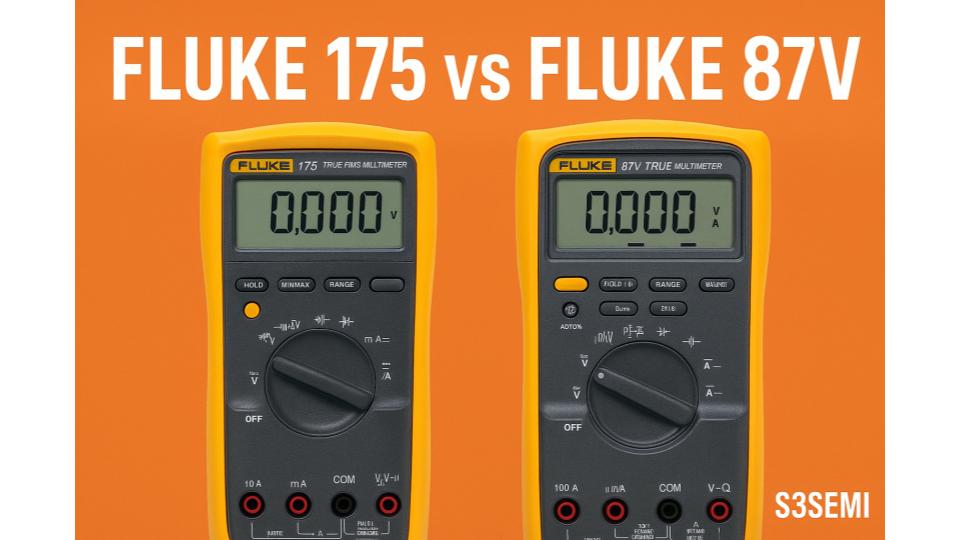When it comes to digital multimeters, Fluke is the gold standard. Both the Fluke 175 and the Fluke 87 V are part of Fluke’s True RMS lineup, but they serve different users.
🏷️ Fluke Multimeter Deals ⭐⭐⭐⭐
The 175 is a reliable, mid-range professional multimeter, while the 87V is considered the flagship for advanced industrial and electronics troubleshooting. If you’re choosing between them, here’s what you need to know.
🔍 Overview
- Fluke 175: Part of the 170 series, it’s designed for professional electricians, technicians, and engineers who need reliable measurements without too many extra bells and whistles.
- Fluke 87V: Part of the 80 series, it’s the benchmark for industrial multimeters. With higher accuracy, advanced measurement functions, and rugged build quality, it’s widely used in labs, factories, and demanding field environments.
📊 Comparison Table
| Feature | Fluke 175 | Fluke 87V |
|---|---|---|
| Voltage Range | Up to 1000 V AC/DC | Up to 1000 V AC/DC |
| Resolution | 6000 counts, 3¾ digits | 20,000 counts (high-resolution mode) |
| Accuracy (DC Voltage) | ±0.15% | ±0.05% |
| Accuracy (AC Voltage) | ±1.0% (True RMS) | ±0.7% (True RMS) |
| Current Range | Up to 10 A | Up to 10 A |
| Frequency Measurement | Yes | Yes, with higher accuracy |
| Capacitance Measurement | Yes | Yes, wider range |
| Temperature Measurement | No | Yes, built-in thermocouple support |
| Display Features | Standard LCD, no backlight | Large backlit display, analog bar graph |
| Safety Rating | CAT IV 600 V, CAT III 1000 V | CAT IV 600 V, CAT III 1000 V |
| Extra Features | MIN/MAX/AVG recording | Low-pass filter, peak capture, selectable filtering for VFDs, high resolution mode |
| Size & Weight | Compact, ~420 g | Larger, heavier, ~700 g |
| 💳 Pricing | 💲Check Price | 💲Check Price |
✅ Pros & Cons
Fluke 175
Pros
- Excellent accuracy and reliability for most professional work
- True RMS for accurate AC readings
- Wide safety ratings (CAT IV 600 V, CAT III 1000 V)
- More affordable than the 87V
- Lighter and easier to carry
Cons
- No backlight, harder to read in dim conditions
- Lower resolution (6000 counts vs 20,000)
- No temperature measurement
- Fewer advanced features for troubleshooting
Fluke 87V
Pros
- Flagship industrial multimeter with advanced accuracy
- 20,000-count high-resolution mode
- Built-in temperature measurement with thermocouple
- Low-pass filter for variable frequency drives (VFDs)
- Backlit display with analog bar graph
- Rugged build, trusted in industrial environments
Cons
- Significantly more expensive
- Larger and heavier
- Overkill if you don’t need advanced features
🧭 Which Should You Choose?
- If you’re an electrician, technician, or engineer who needs a professional-grade multimeter for daily use without breaking the bank, the Fluke 175 is an excellent choice. It’s compact, reliable, and covers all the essential measurements.
- If you work in industrial environments, power systems, advanced electronics, or need the highest accuracy, the Fluke 87V is the clear winner. Its advanced features like temperature measurement, high-resolution display, and filtering for VFDs make it indispensable for complex troubleshooting.
🏁 Final Verdict
Both the Fluke 175 and Fluke 87V are excellent multimeters, but they are aimed at different users. The 175 is the practical, cost-effective choice for most professionals. The 87V, on the other hand, is the industry standard for demanding applications and is worth the investment if you need its advanced capabilities.





